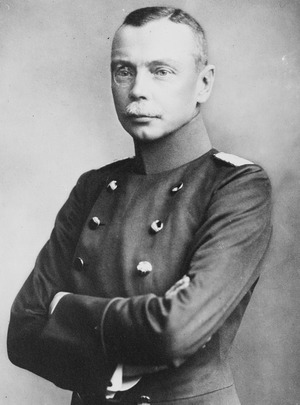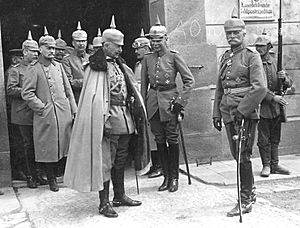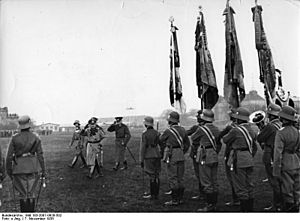Hans von Seeckt facts for kids
Quick facts for kids
Generaloberst
Hans von Seeckt
|
|
|---|---|
 |
|
| 2nd Chief of the German Army Command | |
| In office 26 March 1920 – 9 October 1926 |
|
| President | Friedrich Ebert Paul von Hindenburg |
| Chancellor | Hermann Müller Constantin Fehrenbach Joseph Wirth Wilhelm Cuno Wilhelm Marx Hans Luther |
| Preceded by | Walther Reinhardt |
| Succeeded by | Wilhelm Heye |
| 1st Chief of the German Troop Office | |
| In office 11 October 1919 – 26 March 1920 |
|
| Preceded by | Position established |
| Succeeded by | Wilhelm Heye |
| Chief of the German General Staff | |
|
|
|
| In office 7 July 1919 – 15 July 1919 |
|
| Preceded by | Wilhelm Groener |
| Succeeded by | Position abolished |
| Personal details | |
| Born |
Johannes Friedrich Leopold von Seeckt
22 April 1866 Schleswig, Duchy of Schleswig, German Confederation |
| Died | 27 December 1936 (aged 70) Berlin, Nazi Germany |
| Resting place | Invalidenfriedhof |
| Nickname | 'The Sphinx' |
| Military service | |
| Allegiance | |
| Branch/service | |
| Years of service | 1885–1926 1933–1935 |
| Rank | Generaloberst |
| Commands | Eleventh Army |
| Battles/wars | World War I |
| Awards | Pour le Mérite Military Order of Max Joseph |
Johannes "Hans" Friedrich Leopold von Seeckt (born April 22, 1866 – died December 27, 1936) was a German military officer. He played a key role in planning important victories for Germany during World War I.
After the war, during the Weimar Republic years, he became the commander of the German Army. From 1920 to 1926, he worked to rebuild and reshape the army. He created new ways of thinking about how the army should fight. This included new tactics, organization, and training. His ideas greatly influenced the German army in the first part of World War II. Seeckt also found ways to get around the military limits set by the Treaty of Versailles.
Later, from 1933 to 1935, Seeckt worked in China. He was a military advisor to Chiang Kai-shek. He helped Chiang fight against the Chinese Communists. His plans led to victories against the Chinese Red Army. These battles forced Mao Zedong and his forces to go on the famous Long March.
Contents
Early Life and Military Beginnings
Seeckt was born in Schleswig on April 22, 1866. His family was from Pomerania and had a history of military service. His father was a general in the German Army.
Following his father's path, Seeckt joined the army in 1885 when he was 18. He served in an elite unit called the Kaiser Alexander Guard Grenadiers. In 1897, he joined the Prussian General Staff. This was a group of highly trained officers who planned military operations. By 1913, Seeckt was the Chief of Staff for the III Corps in Berlin.
Hans von Seeckt in World War I

When World War I began, Seeckt was a lieutenant colonel. He served as chief of staff for General Ewald von Lochow. In 1915, he was moved to the Eastern Front. There, he became chief of staff for General August von Mackensen.
Seeckt played a big part in planning Mackensen's successful campaigns. He helped direct the Gorlice–Tarnów Offensive in 1915. This attack broke through the Russian lines. For his efforts, he received the Pour le Mérite. This was Prussia's highest military honor. People in the German army started saying, "Where Mackensen is, Seeckt is; where Seeckt is, victory is."
In 1917, Seeckt was sent to the Ottoman Empire. This was an ally of Germany during the war. He became the Chief of Staff of the Ottoman Army. He worked to help the Ottoman forces, even though the alliance was sometimes difficult.
After the Ottoman Empire was defeated in October 1918, Seeckt returned to Germany. He was involved in the peace talks in Paris. He tried to convince the Allies to limit their demands for Germany's disarmament. However, his requests were denied. In June 1919, Germany had to accept the terms of the Treaty of Versailles.
Building the New German Army
The Treaty of Versailles placed strict limits on Germany's military. It said the army could only have 100,000 men. It also banned modern weapons and the General Staff. Seeckt was put in charge of reorganizing the German army. He had to follow these strict rules. He became the effective chief of the new German army, called the Reichswehr, in October 1919.
Seeckt believed that war was a part of history. He felt it was important for Germany to be ready to defend itself. He wanted the German army to keep its strong, offensive spirit. He said that German officers should always remember past military achievements. This would keep them ready to fight if Germany needed to defend itself again.
The Reichswehr was designed to be a small, highly skilled force. It could be expanded quickly if needed. Officers and non-commissioned officers (NCOs) were trained to lead larger units than their current rank. This meant they were ready for bigger roles. Many of the leaders of the Wehrmacht (Germany's army in WWII) were men Seeckt had kept in the Reichswehr.

Seeckt had conservative political views. He wanted to keep the army separate from politics. He believed the Reichswehr should act as a "state within the state." This meant it would operate largely outside the control of politicians.
He also saw Poland as a problem for Germany. He believed Germany should work with the Soviet Union. Both countries had lost land to Poland. Seeckt saw this alliance as practical, not based on shared beliefs. It would make both nations stronger.
In 1920, a group tried to overthrow the German government in what was called the Kapp Putsch. Seeckt refused to order the Reichswehr to fight against them. He said, "Reichswehr do not fire on Reichswehr." This showed his lack of loyalty to the young Weimar Republic. The government had to flee Berlin. The putsch failed only after a general strike shut down the country.
Seeckt also created secret groups to help Germany get around the Treaty of Versailles. One group, the GEFU, helped build arms factories in the Soviet Union. This allowed Germany to keep up with military technology. It also laid the groundwork for Germany's rearmament in the 1930s.
Seeckt was concerned with making Germany strong again. He believed France was the main threat. He thought England might eventually ally with Germany against France. He believed a strong Germany would be a better ally.
He was forced to resign on October 9, 1926. This happened because he invited Prince Wilhelm, the former emperor's grandson, to army exercises. The prince wore an old imperial uniform without government approval. This caused a public outcry.
The Roots of the Wehrmacht
The German army that fought in World War II was largely shaped by Seeckt. The fighting methods and operational ideas of the Wehrmacht came from Seeckt's work in the 1920s. He set up 57 committees to study World War I. They looked for lessons to use in the next war.
This led to a 1921 book called Leadership and Battle with Combined Arms. It described how different military branches (artillery, infantry, tanks, air power) should work together. Seeckt imagined Germany winning future wars with fast, mobile attacks. These attacks would use combined forces to overwhelm the enemy. He also saw a big role for air power. He kept many officers with air combat experience in the Reichswehr. These officers later formed the core of the Luftwaffe (German air force).
Later Years and China

After leaving the army, Seeckt was elected to the Reichstag (German parliament). He served from 1930 to 1932.
From 1933 to 1935, he worked as an advisor to Chiang Kai-shek in China. He helped improve military cooperation between China and Germany. Seeckt advised Chiang to build a strong, modern army of 60 divisions. He wanted the best Chinese officers to be trained in modern warfare. His goal was to make China's army highly professional, like the Reichswehr.
Seeckt also suggested a trade agreement between China and Germany. Germany would get minerals like tungsten for weapons. China would get weapons and machines to make its own weapons. In 1934, Chiang made Seeckt his Chief Military Advisor. Seeckt's plans for building a strong Chinese army were adopted.
In 1934, Seeckt advised Chiang on how to fight the Chinese Communists. He suggested building forts and roads around Communist-controlled areas. This would force the Communists to fight in the open. These tactics led to defeats for the Communists. This eventually led to the famous Long March in October 1934.
Hans von Seeckt died in Berlin on December 27, 1936. He was buried at Invalidenfriedhof.
Decorations and Awards

- Iron Cross (1914), 1st and 2nd class
- Pour le Mérite with oak leaves
- Order of the Red Eagle, 4th class with crown
- Order of the Crown, 3rd class (Prussia)
- Prussian Service Cross Award
- Commander of the Military Order of Max Joseph
- Military Merit Order, 2nd class (Bavaria)
- Knight's Cross of the Albert Order, 2nd class with Swords
- Commander of the Order of the Crown (Württemberg)
- Hesse Bravery Medal
- Hanseatic Cross of Hamburg
- Military Merit Cross, 1st class (Mecklenburg-Schwerin)
- Friedrich August Cross, 1st class
- Commander, First Class of the Ducal Saxe-Ernestine House Order with Swords
- Commander of the Order of Saint Stephen of Hungary
- Order of Leopold, 1st class (Austria)
- Order of the Iron Crown, 1st class with War Decoration
- Military Merit Cross, 2nd class with War Decoration (Austria-Hungary)
- Star of the Decoration for Services to the Red Cross
- Gold Imtiyaz Medal (Ottoman Empire)
- Order of Osmanieh, 1st class with swords (Ottoman Empire)
- Order of the Medjidie, 1st class with swords (Ottoman Empire)
- Gallipoli Star (Ottoman Empire) ("Iron Crescent", Ottoman Empire)
- Order of Bravery, 2nd class (Bulgaria)
- Grand Cross of the Order of Military Merit (Bulgaria)
See also
 In Spanish: Hans von Seeckt para niños
In Spanish: Hans von Seeckt para niños
- Sino-German cooperation until 1941


